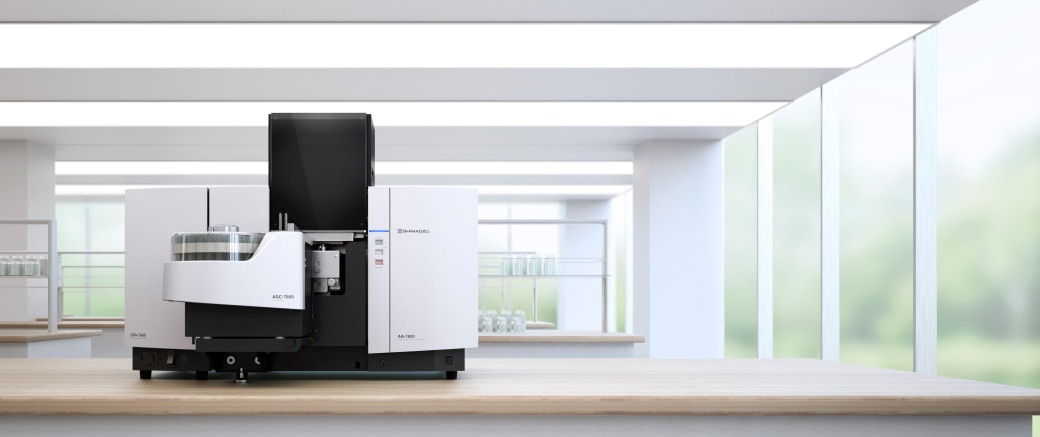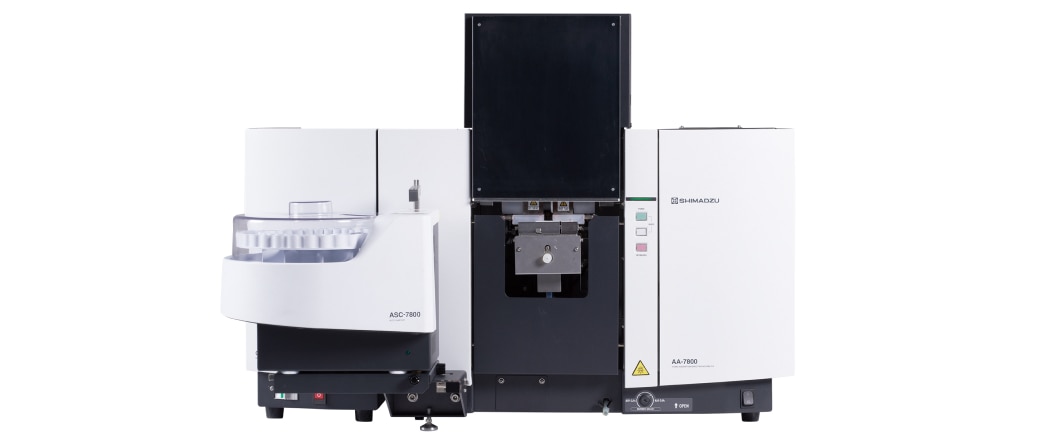World’s Smallest Dual System
- Shimadzu's AA-7800 Series For Advanced Atomic Absorption Spectroscopy

The Shimadzu Atomic Absorption Spectrophotometer AA-7800 Series is versatile enough for a variety of analytical applications (Any Application), safe and easy to use even for beginners (Any User), and offers continuous analysis using autosamplers and remote data analysis via network connections to increase the flexibility of the analysis operator's work style (Any Location).
These new spectrophotometers enable safe, high-performance flame analysis. For flame atomic absorption spectrometers that use acetylene gas, AA-7800 spectrophotometers are equipped standard with a variety of safety mechanisms, such as a vibration sensor and a gas leak check function. Double-beam optics and many other extra features ensure reliable data acquisition. In addition, users can analyze a variety of samples using the extensive selection of functions and options.
Discover our AA-7800 Series here
A Quick Introduction of Atomic Absorption Spectrophotometers
Atomic absorption spectrophotometers (AA) are commonly used to determine the type and concentration of inorganic elements in liquid samples. They make use of the fact that elements absorb light at specific wavelengths.
These instruments are used not only in the food industry, but also for environmental, pharmaceutical, and chemical analysis. They have advantages over other elemental analyzers in that they have a smaller installation footprint, can be easily introduced, provide excellent throughput, have low detection limits for picking up trace elements, and offer low running costs. Accordingly, they are often chosen as the first instrument for elemental analysis.
The measurement of calcium in milk is an example of how an AA system can be applied to something familiar. Milk is widely known as a food product that contains calcium. Since calcium is a mineral and inorganic, it can be measured with AA systems.
In fact, a large number of AA systems are installed and utilized for R&D and QA/QC departments in dairy product companies, as well as in contract research laboratories specializing in food analysis.
Key Features of Shimadzu’s AA-7800 Series

AA systems are used in various industries, including food & beverage, environmental, pharmaceuticals, and materials, as well as in educational institutions. Atomic absorption spectrometry (AAS) as an analytical technique has been adopted for many official test methods, so it is expected to have strong demand for these systems in the future.
The concepts behind the new AA-7800 series are “Any Application,” “Any User,” and “Any Location.” They are compatible with a wide range of uses and provide comprehensive safety features and enhanced operation, enabling even novices to use them with confidence. Thanks to their features, they can be installed in many different types of environments and analytical operators can work more flexibly through remote data management.
- Any Application
The AA-7800 Series offers expandability through the addition of units, enabling the system to accommodate various analysis targets. It can support a wide range of analysis applications, including:
- Environment (e.g., seawater, river water, effluent, sludge, air-borne dust)
- Metals, semiconductors, ceramics (e.g., metals, minerals, glass, ceramics, IC chips)
- Petroleum, chemical, polymers (e.g., petroleum, oil, catalysts, chemical products, biodiesel)
- Medical, biology, pharmaceuticals (e.g., blood, animals, plants, drugs, foods)
AA-7800 systems can be modified based on how it is used. Moreover, it has eight hollow cathode lamps to provide ample capacity for analyzing multiple elements. Its flame system even supports samples with high concentrations or organic solvents. Moreover, with high-sensitivity optical sensor and precise temperature control, AA-7800 systems ensure high stability that contributes to accurate and reliable measurements across a wide range of sample solutions and concentrations, making it a valuable addition to the laboratories.
- Any User
The AA-7800 exemplifies a user-friendly and optimized design through its clear and easy-to-use WizAArd software as well as the ability to provide automatic optimization functionality for easy operability.
Moreover, coupled with multiple functionalities to support analytical condition development, a simple and easy-to-use furnace system, and more advanced safety technology, AA-7800 can be intuitive to use even for beginners new to atomic spectroscopy.
- Any Location
The AA-7800 is the world’s smallest dual system that is only 940mm wide. Equipped with a space-saving design, AA-7800 is also exceptional in its performance due to low carryover and advanced functionality. Up to 4 kinds of samples (such as diluents, standard solutions, samples, or matrix modifiers) can be mixed together before injection. Either a fluoropolymer tube or pipette tip can be selected as the injection nozzle. Samples can be automatically diluted and re-measured if the concentration exceeds the calibration curve concentration range.
Application Spotlight: Analysis of Cadmium in Brown Rice by Flame Atomic Absorption Spectroscopy

Cadmium is found in many foods, including rice, vegetables, fruits, meat, and fish. In Japan, the highest intake of cadmium comes from rice, which is estimated to account for about 40% of total intake. In 2010, the Food Sanitation Act was amended to specify that "brown rice and polished rice should not contain more than 0.4 ppm (mg/kg) of cadmium," with the regulation being strengthened from the previous standard of less than 1.0 ppm (mg/kg).
The current official method requires the wet ashing of brown rice samples with strong acid (sulfuric acid and nitric acid) followed by extraction with methyl isobutyl ketone using a chelating agent (sodium diethyldithiocarbamate). That method has problems with taking a long time for decomposition, poor operating efficiency, analyst exposure to hazardous materials, and disposal of liquid waste.
Shimadzu presents a solution using a simple screening method (not compliant with the official method) to quickly provide high sensitivity cadmium measurement results. This can be done by extracting and filtering brown rice components with diluted acid and measuring it directly with the latest AA-7800, using flame atomic absorption spectrometry.
Experience Infinite Possibilities with our AA-7800, Built for Any Application | Any User | Any Location
The AA-7800 is the World's Smallest Dual System designed to be versatile for various analytical applications (Any Application). With automatic optimization functionality and advanced safety technology, AA-7800 is safe and easy to use even for beginners (Any User). It also offers continuous analysis using autosamplers and remote data analysis via network connections for greater flexibility (Any Location).
Thank you for reading! If you are interested in our updates, stay connected with us via our Newsletters, Digital Classrooms, LinkedIn, Facebook, or Youtube.


